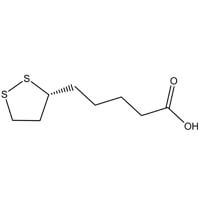 Alpha lipoic acid is an antioxidant that is made in the body. It is found in every cell where it acts as a cofactor for enzymatic complexes. Alpha lipoic acid's main role is to help turn glucose into energy.
Alpha lipoic acid is an antioxidant that is made in the body. It is found in every cell where it acts as a cofactor for enzymatic complexes. Alpha lipoic acid's main role is to help turn glucose into energy.
Most antioxidants are either water-soluble (such as vitamin C), or fat-soluble (such as vitamin E), but alpha-lipoic acid is both water and fat-soluble. That means it can work throughout the body. Alpha lipoic acid crosses the blood-brain barrier, meaning that it enters the brain easily. Its antioxidant properties allow alpha lipoic acid to support the body's natural ability to manage free radical activity. Because alpha-lipoic acid can pass easily into the brain, it may also help support the health of the brain and nerve tissue.
Alpha lipoic acid has two forms, known chemically as optical isomers (enantiomers). They are R-lipoic acid (RLA) and S-lipoic acid (SLA). RLA is the biologically superior form of alpha lipoic acid since it is identical to that produced by the body. Research indicates that RLA is responsible for the most beneficial effects of alpha lipoic acid. Alpha lipoic acid is converted into dihydrolipoic acid in the body.
SLA doesn't exist in nature and research indicates that it is not well absorbed by the body.
Many foods contain alpha-lipoic acids, they include spinach, broccoli, yams, potatoes, yeast, tomatoes, and beets to name a few. Red meat, especially organ meat is also a source of alpha lipoic acid.
Alpha-lipoic acid is not the same as alpha linolenic acid, which is an omega-3 fatty acid. There is confusion between alpha-lipoic acid and alpha linolenic acid because both are sometimes abbreviated ALA. Alpha-lipoic acid is also sometimes called lipoic acid.
Xtend-Life uses a bio-enhanced, stabilized form of RLA supplied by GeroNova. This ingredient is the gold standard in lipoic acid because it provides superior absorption over other forms of RLA. Research shows that people who took GeroNova's bioenhanced RLA achieved blood concentrations of lipoic acid a full 40 times higher than those who took un-stabilised RLA.
R-lipoic acid's antioxidant properties provide it with many benefits. RLA is most often used for conditions and complications relating to unhealthy blood sugar levels or excess body weight, such as metabolic syndrome or diabetic neuropathy.
Alpha lipoic acid has also demonstrated interesting cardiovascular, cognitive, anti-aging, detoxifying, anti-inflammatory, and neuroprotective properties.
The most common reason for taking alpha lipoic acid is pain, burning, tingling, or numbness in the arms and legs occurring as a complication of diabetes. This condition is referred to as diabetic neuropathy. Diabetic neuropathy can affect other nerves too - in the digestive system, urinary tract, blood vessels, and heart.
Additional signs that you may benefit from alpha lipoic acid include absentmindedness or having difficulty with memory recall.
Salehi, E et al. Insights on the Use of α-Lipoic Acid for Therapeutic Purposes. Biomolecules. 2019 Aug; 9(8): 356.

As women age, hormonal changes during menopause can have a significant impact on their skin. The decrease in estrogen levels can lead to a variety of skin issues, including dryness, thinning, and increased wrinkles. But did you know that what you ...

Support Healthy Cell Function Alpha Lipoic Acid Background and Benefits Alpha lipoic acid is an organosulfur compound that is biosynthesized by all animals. It is a cofactor in many enzymes and an essential component of aerobic metabolism. One of alpha lipoic acids' most well-known biochemical us...

Antioxidant Support Glutathione Background and Benefits Glutathione is a tripeptide, which is a molecule consisting of three amino acids linked together by chemical bonds. It is an important nutrient in many organisms, including plants, animals, and some bacteria. Glutathione has strong antioxida...
Shipping calculated at checkout